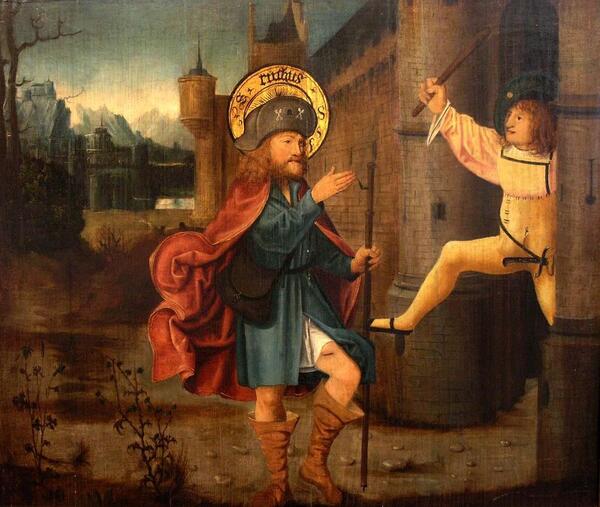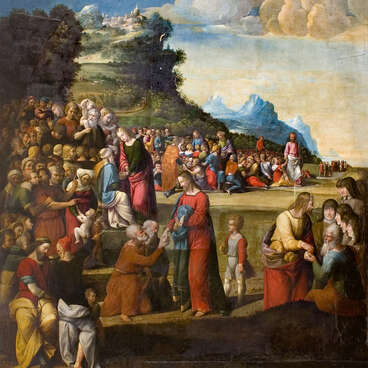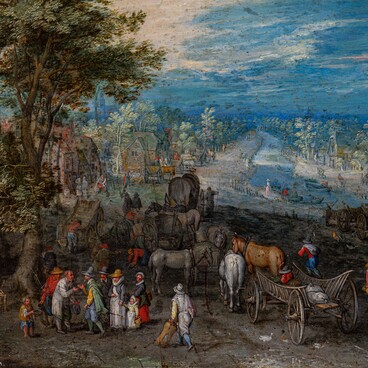The “Expulsion of Saint Roch from Rome” is a characteristic example of the altarpiece of Southern Germany of the beginning of the 16th century. At this turning point in German culture, the ideas of the Renaissance began to penetrate into the medieval tradition. New influences coming from Italy first manifested themselves in Swabia, a historical region on the upper Rhine and Danube. In the 14th century the city of Ulm became the artistic center of Swabia. In its famous cathedral there were about 60 winged altars decorated with thematic representations.
The story of the Expulsion is taken from the legend of the Catholic saint Roch, one of the popular Christian figures believed to be the protector against the plague. According to the legend, Roch, having lost his parents, gave away all his possessions to the poor and went as a pilgrim to Rome. The plague was raging in Italy at the time, and he began wandering through the country, caring for the sick, healing them with prayer and the sign of the cross. In Piacenza, Roch himself contracted the “black death”, was expelled from the city and wandered off to await his death in an abandoned cabin in the woods. The legend has it that the local duke’s dog brought him some bread. The saint soon recovered: he was healed of the plague by an angel who descended from heaven.
Scenes from the life of this Catholic saint were portrayed by artists for several centuries. An unknown German painter presented the moment of Roch’s expulsion from Piacenza. The painting features some of his traditional attributes: a wanderer’s cloak, a plague spot on his left leg, and a pilgrim’s staff in his hand.
Roch is often depicted together with a dog holding bread in its mouth. Sometimes the paintings show another character from this story, an angel curing the sores of the Catholic saint.
The picture of the Expulsion is executed by a clearly conservative master. Nevertheless, it is a vivid illustration of the transition from the old art to the new. The palette, the arrangement of the figures, and the interpretation of the angel’s wings belong to medieval art. Yet, the emerging shift in the understanding of space, as well as the genre character of the scene and the appearance of landscape background testify to a clear influence of the Italian art. The colors are distinguished by their purity, transparency of tones and radiance. This desire for intensity was explained by the idea that the foundation of all colors is light, and light signified the presence of God.
The story of the Expulsion is taken from the legend of the Catholic saint Roch, one of the popular Christian figures believed to be the protector against the plague. According to the legend, Roch, having lost his parents, gave away all his possessions to the poor and went as a pilgrim to Rome. The plague was raging in Italy at the time, and he began wandering through the country, caring for the sick, healing them with prayer and the sign of the cross. In Piacenza, Roch himself contracted the “black death”, was expelled from the city and wandered off to await his death in an abandoned cabin in the woods. The legend has it that the local duke’s dog brought him some bread. The saint soon recovered: he was healed of the plague by an angel who descended from heaven.
Scenes from the life of this Catholic saint were portrayed by artists for several centuries. An unknown German painter presented the moment of Roch’s expulsion from Piacenza. The painting features some of his traditional attributes: a wanderer’s cloak, a plague spot on his left leg, and a pilgrim’s staff in his hand.
Roch is often depicted together with a dog holding bread in its mouth. Sometimes the paintings show another character from this story, an angel curing the sores of the Catholic saint.
The picture of the Expulsion is executed by a clearly conservative master. Nevertheless, it is a vivid illustration of the transition from the old art to the new. The palette, the arrangement of the figures, and the interpretation of the angel’s wings belong to medieval art. Yet, the emerging shift in the understanding of space, as well as the genre character of the scene and the appearance of landscape background testify to a clear influence of the Italian art. The colors are distinguished by their purity, transparency of tones and radiance. This desire for intensity was explained by the idea that the foundation of all colors is light, and light signified the presence of God.



